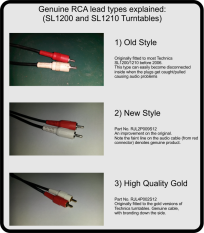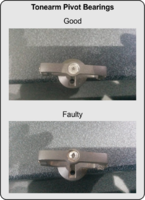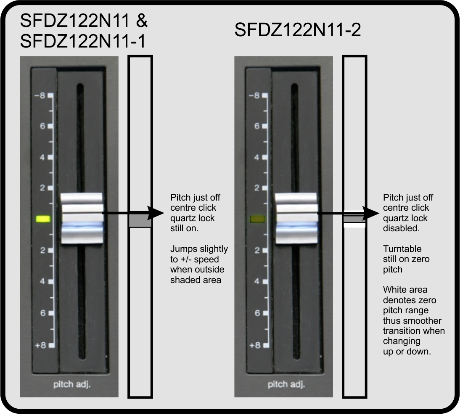
Info & FAQ's
FAQ's, Technical tips & Useful facts.
Scroll all the way down and have a good read as there is plenty of interesting information which is otherwise difficult to find online
Section 1 - Modifications
Please note that non-reversible modifications can lower the value of your turntables.
Q: How long does it take to service a pair of turntables?
A: It takes 2.5 to 3 hours to carry out a full service and calibration on each turntable, which includes a load test. Usual turnaround time is about 3 days if sending via courier but same day servicing can be booked by appointment. Beware of people offering to service turntables in under 2 hours each, it is impossible to do this properly in such a short space of time.
Q: Can you come to my premises and service my turntables?
A: Due to the large amount of test equipment and tools required to carry out a full thorough service, it is not possible to do this as it would be impossible to transport everything. Whilst some technicians may offer this service, you would never get a a full proper service with the limited tools they carry, as an enhanced service is now required due to the turntables being be at least 20 years old. My workshop is equipped with everything needed to carry out a full proper service including bench test equipment, oscilloscopes, thermal imaging for diagnostics and the largest stock of genuine parts on the shelf here in the UK.
Q: I have seen cheaper quotes elsewhere for servicing, Can you match this?
A: No. Beware of people offering cheap servicing as you do get what you pay for and these people often have little or no formal qualifications. As a qualified engineer I go far beyond the standard servicing mentioned in the service manual. Proper calibration is not just a case of adjusting a couple of potentiometers with a frequency counter. All adjustments are carried out under oscilloscope, checking through many test points on the main PCB and comparing waveforms. As such this does take longer as every component is checked, even solder joints reflowed on the main PCB (where it has been known for some of these to wear over time causing issues) Also dont forget that the standard service includes replacement pitch, audio and ground leads so altogether fantastic value for money.
Q: Can you carry out LED modifications?
A: Yes, The most common one of these is to the popup target lamp, which can be changed to a LED. I can also carry out modifications to the other LEDs on the turntable, and am careful to choose quality branded LEDs by TruOpto, which arent too bright and have a better quality light output. I do not recommend fitting any cheap LED kits often found on auction sites.
Q: I would only like a single repair carried out, I dont want a full service. Is this possible?
A: No because it is not cost-effective to do this due to the labour costs involved when compared to a service. Every turntable which comes into the workshop will need to undergo a service so that I know it is fully functioning properly when it leaves. This gives the best value for money and ensures your turntables should work fault-free for many years. By constantly having single repairs carried out means your turntables would forever be 'back and forth' into the workshop for repairs as they age. That is not something which I am prepared to do.
(The only exception to this rule is in the highly unlikely event a turntable has developed a fault which you previously brought into me for a service)
Q: The pitch dots on my turntables do not line up accurately with the scale, Can this be fixed?
A: Over the years there has been variations with the AN6682 VCO, which causes turntables to behave differently dependant on age. This was mainly down to the original pitch models (SFDZ122N11) being 20kOhm value, and the later pitche models being 22kOhm (SFDZ122N11-1, -2 and -3), where the area around the 0% (null point) is slightly larger on all pitch types. This in turn has slightly 'squeezed' the resolution outwards thus the dots may line up a little later than expected, even after calibration. However because of the pitches being slightly more logarithmic, you do still get the full +8% and -8% range. The main aim when servicing is to re-calibrate the 6% (6.4% on mk5) and of course the centre zero point. This will then give the correct scale even though the 3.3% may not be accurate.
Q: Can I have my turntables internally grounded to eliminate the ground wire?
A: No. I will absolutely not do this as it falls below the standard of my work due to the problems it can cause. The chassis ground and audio ground are kept separate for many in-depth technical reasons. Many technicians who do this mod do not posess the fundemental electrical knowledge in both electrical and electronic engineering, which when combined gives you a bigger picture allowing you to see the issues. Whilst people can get away with this for some time it can pose serious interference problems.
The topology of a Technics SL turntable makes it a class 2 electrical appliance, and as such the chassis ground must ensure that any residual current is fed to another chassis and must not be carried
through the audio cable of which the screen is purely functional, especially as some mixers isolate the audio ground from the chassis. You will also find that there is risk of interference as
internal grounding will in effect turn the chassis into a large antenna, attracting RF interference down the audio and inducing in the centre cores of the leads bypassing any RF filtering. I have
seen examples of this where the only cure was to separate the ground.
Knowing the difference between grounding, bonding and earthing gives a better picture in all of this, and there are safety aspects too. Any turntable brought to me which is internally grounded will have this put back to normal as part of the service.
Again there are many more reasons which can get very technical, which is why the ground wire was added by Technics in the first place.
Please see the information below on internal grounding:
Further information regarding internal grounding. (PDF download)
Internal Grounding Info.pdf
Adobe Acrobat document [500.6 KB]
Q: Everything is set up correctly, new carts and styli, records are clean yet for some reason the sound is still dull and i'm getting feedback. Why is this?
A: My first question on this will be: Are you using a Pioneer mixer? These mixers, ever since the DJM600 release have always had poor phono RIAA inputs which makes vinyl sound worse than it really is, notably causing feedback due to a 70Hz wideband boost and also a rolloff above 12khz causing muddiness. Whether they did that to seemingly enhance the audio from digital CDJ's is anyones guess but this seems to me one of the main reasons when diagnosing for poor sound quality. They are a hifi brand and not very good at selecting pro audio components. You will also notice that these mixers often have no mains earth which can add to problems. If you can get hold of another brand of mixer (ideally with 3 pin mains inlet) then give that a try.
Please see the information below on feedback from pioneer mixers:
Document explaining in more detail the issues with pioneer mixers.
Pioneer Mixer Feedback.pdf
Adobe Acrobat document [211.0 KB]
Q: I have a mk2 turntable and would like the pitch range increased beyond +/-8%. Can you do this?
A: I strongly do not recommend this, because the resistance and design of the VCO driven motor control can start to become unstable. As a
result I refuse any request to do this and will always calibrate to 8%. For bigger pitch variations you want the Mk5G or the newer G, GR, GAE and Mk7 models.
it is also worth noting that the analogue VCO pitch is preferred by the majority of DJs due to the fact that it is infinitely variable between the + and - 8% regions whereas the Mk5G and newer models
have a digitally controlled pitch where the resolution is 'stepped'. Turntables with an analogue VCO pitch which have been serviced and fitted with a new pitch slider will certainly be more accurate
and more responsive.
Q: If I spend £100 on a set of quality cables would this improve the sound?
A: Not necessarily. The best cables for these turntables are the Technics branded Part number RJL4P002S12 which has very high quality OFC cable and gold plated connectors. The standard cables are
part no RJL2P009S12 which now fitted as standard as part of a service (included in the service parts cost). Both have very good core-screen capacitance specifically designed for RIAA
equalisation curve which is on all tonearm pickups. The premium gold plated cables give the best technical specifications over the standard cables which they come with and are given as a option when
booking for a service. Plus they fit correctly in the clamp under the base of the tonearm where many thicker cables will not fit and can cause issues. The illustration below shows the different types
(click to enlarge).
Q: Can you respray and customise turntables?
A: Due to limited workshop space it is not possible for me to do this as specialist equipment would be needed. My expertise lies more with the electronic servicing. Its important to know that more often than not a good clean is all they need, which is carried out when servicing. Rest assured though that electrically and mechanically they will be working like new after a service.
Q: Is there any way to reduce feedback on my turntables?
A: Always make sure that the only part of the turntable making contact with the surface are the feet. Everything else must not be touching anything whatsoever. Especially at an event, make sure the turntables are out of the flightcases. Again pioneer mixers can add to this problem as they have a terrible boost at around 70Hz, aswell as 35Hz and 140Hz (one octave down and up respecttively) - This will add to feedback issues.
Section 2 - Useful Tech Tips
You've just put a cartridge into the tonearm, its 5 minutes before your set and only one channel is working.
We've all been there, thinking the worst that the audio cables have suddenly packed up. Well fear not as there is a handy tip for this. Just take out the cartridge and go over four pins on both
the cartridge and inside the tonearm with the end of a pencil. Then replace making sure the cartridge is tight into the tonearm.
What happens is over time, corrosion can build up through an electrolytic reaction from the very small current, moreso if theres dissimilar metals making contact. The pencil trick gives a good
temporary fix to this problem when at a gig, which can be dealt with more permanently through the use of IPA solvent and a cotton bud.
Watch out for wobbly tonearms.
The bearings inside the tonearm pivots do not take much battering to make them fall apart. Often people get a little bit of a wobble and think that tightening the screw will sort it. Most of the
time it will make things much worse. These screws are set to a torque with a very tight precision tolerance (within 0.1mNm) as the bearings need to run freely without slack whilst not being too tight
so as to impede the tracking on the vinyl.
Simply put, too tight a bearing and it will fall apart as the wobble is often caused by a knock to the pivot, causing a gap for the bearings to fall out. It looks like shiny bits of dust which rolls
around - yep the bearings are that tiny.
I always check and oil the tonearm bearings when carrying out a service, this is a close up of what one looks like, with what can happen:
Section 3 - Useful Tech Info
Clickless pitch sliders are not the same!
For MK3 and MK5 turntables the part you need is SFDZ122N11-3
For MK5G turntables you need SFDZ122N11-4
Neither of these will work properly in mk2 turntables, however the ordinary mk2 pitches can be de-clicked if needed.
Serato/Traktor BPM fluctuation explained - and it might be nothing to do with faulty pitch :
People often ask why the BPM fluctuates slightly on serato/traktor when using vinyl timecode. The reason is that it may not always be the pitch stability of your turntables causing the problem.
If you look closely (you may need a magnifier) at the tonearm, you may notice it moves left to right everso slightly when the record is playing. This is due to the record not being 'dead centre'
So when the record spins around, it makes the tonearm move inwards and outwards. This makes the track speed up and slow down a little. You only need a very slight movement of 0.1mm (one tenth of a
millimetre) for this to have an effect, so whilst the 'average' BPM stays correct, you will see + and - fluctuations. As the tonearm moves outwards, circumference increases and so does the speed of
the track passing the needle, likewise as the tonearm moves inwards, the reverse happens (less circumference, slower track speed)
Add to that the latency of your digital software and that is why the fluctuations may not seem consistent every rotation. However do not panic, because the average BPM will always be spot on.
Its because whilst the same fluctuation movement applies throughout the whole track, the distance becomes relatively greater in percentage in relation to the ever decreasing radius as the stylus
moves towards the centre. Thus average circumference (2πr) sets the average bpm. Now lets call the deflection d, then if you get the maximum deflected radius (2π(r-d)) or (2π(r+d) (depending on inner
or outer movement) that then gives you the multiplication factor to use when average = 100% or the value of 1, so when you multiply the bpm by the negative figure, you get the lower bpm value, and
the positive figure gives you the higher bpm value.
For example, youre 2 inches into a track on a 12 inch timecode, so say 10 inches of vinyl (254mm /2 = 127mm radius.) remains.
Deflection is 1mm. Tune is 130BPM.
Multiplication factor, divide deflected value by average, so 126mm/127mm = 0.992 for negative deflection, and 128mm/127mm = 1.008 (rounded) for positive
So with a 130BPM x 0.992 - 128.96BPM on your negative deflection, 131.04BPM on positive deflection.
It is worth noting that whilst you see this happening with timecode - with normal vinyl this is indistinguishable to the human ear unless you get a really bad speed wobble.
Interesting fact - Two pitch types for mk2 explained:
(See this video for more info)
People often experience conflict when beatmatching, as the turntable can behave sporadically when just off the centre click. This happens when the more common SFDZ122N11 (-1) pitch
is fitted.
The conflict is caused when the VCO and Quartz lock are both trying to compete causing the green light to go dim or flicker. You will notice the illustration below shows the pitch at the same position on the carbon track, yet in only one instance the green light (quartz lock) is illuminated.
With the SFDZ122N11-2 these are manufactured differently, with a shorter lock travel, and as shown in the white shaded area, the pitch will still be at zero thus smoothly transitioning to plus or minus with little or no conflict when just off the centre click.
The actual pitch zero range on the carbon track is shorter than the quartz lock range on the SFDZ122N11 (-1) hence the risk of speed conflict.
The SFDZ122N11-2 is not available to order on its own online (when you order mk2 pitches online from anywhere will be the other type SFDZ122N11-1 unless specifically stated) however having a good source of these -2 pitches, it is these which I fit when servicing turntables.





